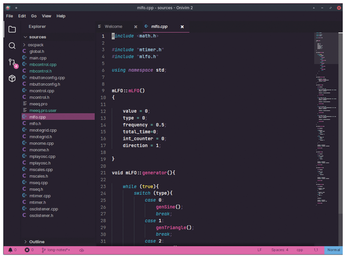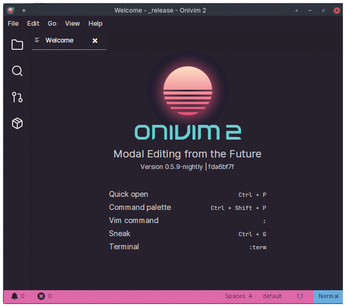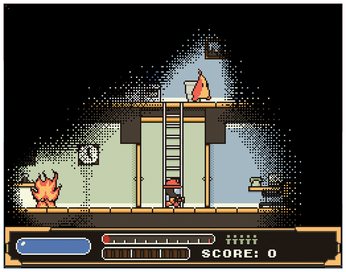FOSSPicks
Onivim 2
The Vim text editor doesn't normally need much of an introduction. It's the yin to the Emacs yang, the source of many "How do I quit?" posts, and the fuel for many a late night best-editor argument. It's a terminal text editor driven by infamously opaque keyboard commands that need to be committed to memory and normal, visual, insert, and select operating modes that can totally confuse a generation brought up on Microsoft Word. But it is also ubiquitous, powerful, mature, and ultimately wedded to the command line. There have been many attempts to bring its uniqueness to the desktop, but most of us would rather simply open a terminal and edit our files from there. If we need to make a graphical editor more Vim-like, there's usually an option to switch its keybindings to those of Vim. Editors such as Plasma's Kate and Microsoft's Visual Studio Code take this further with plugins that can even ape the command and editing modes, alongside all the muscle memory shortcuts and keyboard commands.
Onivim 2 is a new graphical editor that, even in its alpha state, is already one of the most successful desktop editors we've seen at supplanting Vim's workflow from the command line to a modern desktop environment. Like Vim, it's modal, which means you can edit text not just interactively (as you would with a normal desktop editor) but also by issuing commands that typically consist of a verb followed by a motion, such as d$ to delete to the end of a sentence. This is exactly the same as how Vim works. But it isn't just Vim that Onivim 2 is hoping to replace: It's attempting to bring the best of editors such as TextMate, Sublime Text, and Visual Studio Code editor to a single high-performance application. Despite being completely independent of these projects, the editing experience is already fairly comprehensive. It features syntax highlighting, fuzzy search across a project, snippets, and a command palette, all packaged within an amazing cross-platform application shell that isn't using Electron.

The project has an interesting licensing policy, which also makes it difficult to get hold of the application in its alpha state without contributing. The project is a commercial endeavor, currently funded by Patreon supporters, but ultimately, paid-for license keys. The code is initially released under a non-free license, allowing only for non-commercial and educational use without a commercial license, and it takes a long time to build (we built the code manually). But due to the positive support the project has received from the open source communities, Onivim 2 now has a dual-licensing agreement. Eighteen months after a commit has landed in its code repository, it will become additionally licensed under MIT, which is when we'll all be free to make and distribute our own builds. This isn't a perfect solution, and it would be preferable if the project were open source from every commit, but we equally respect the project's decision and motivation. It's hard bootstrapping a business, building a new editor, and maintaining momentum. Hopefully, the project will be successful enough, and so well-funded regardless of its licensing restrictions, that the developers will update their licensing to remove the long delay. Either way, Onivim 2 is definitely worth seeking out.
Project Website

Retro platformer
Mr. Rescue
We've looked at the L÷VE games framework before. It's a brilliant way to easily create 2D games with the accessible LUA language. Many developers have already used it to create unique and fully fledged games. Mr. Rescue is one of these. Like many of the games built using L÷VE, Mr. Rescue has a lovely pixelated design reminiscent of games from the 8-bit era, albeit on a console with a 24-bit color palette. The game's objective is equally positive. Rather than trying to destroy things, you save people by running through an already burning building, picking them up, getting to a window, and throwing them out. There's no mention of their fate from this point, especially when the buildings can stretch dozens of floors into the sky, but let's assume there's some substantial landing setup waiting for them. Another thing to remember is to open the window first.
Your only defenses against the fire are your suit, which gets increasingly damaged the closer you get to the flames, and your fire extinguisher, used to blast the flames with water to make a path through the building, as well as to smash open windows and doors. You can only blast the water for so long before needing to wait for the pressure to replenish, and your suit also needs to be recharged by finding coolant capsules as you explore the building. If you don't do this, you'll eventually overheat and the game will be over. In this way, the game builds up momentum as you try and take more risks to save people while fighting the fire. When you've saved a certain number of people, the level is over and you move on to another building. It's a great game that's brilliantly animated and finely tuned, with a soundtrack that could have been produced on a Commodore Amiga in 1988.
Project Website
https://tangramgames.dk/games/mrrescue/

Buy this article as PDF
(incl. VAT)
Buy Linux Magazine
Subscribe to our Linux Newsletters
Find Linux and Open Source Jobs
Subscribe to our ADMIN Newsletters
Support Our Work
Linux Magazine content is made possible with support from readers like you. Please consider contributing when you’ve found an article to be beneficial.

News
-
NVIDIA Released Driver for Upcoming NVIDIA 560 GPU for Linux
Not only has NVIDIA released the driver for its upcoming CPU series, it's the first release that defaults to using open-source GPU kernel modules.
-
OpenMandriva Lx 24.07 Released
If you’re into rolling release Linux distributions, OpenMandriva ROME has a new snapshot with a new kernel.
-
Kernel 6.10 Available for General Usage
Linus Torvalds has released the 6.10 kernel and it includes significant performance increases for Intel Core hybrid systems and more.
-
TUXEDO Computers Releases InfinityBook Pro 14 Gen9 Laptop
Sporting either AMD or Intel CPUs, the TUXEDO InfinityBook Pro 14 is an extremely compact, lightweight, sturdy powerhouse.
-
Google Extends Support for Linux Kernels Used for Android
Because the LTS Linux kernel releases are so important to Android, Google has decided to extend the support period beyond that offered by the kernel development team.
-
Linux Mint 22 Stable Delayed
If you're anxious about getting your hands on the stable release of Linux Mint 22, it looks as if you're going to have to wait a bit longer.
-
Nitrux 3.5.1 Available for Install
The latest version of the immutable, systemd-free distribution includes an updated kernel and NVIDIA driver.
-
Debian 12.6 Released with Plenty of Bug Fixes and Updates
The sixth update to Debian "Bookworm" is all about security mitigations and making adjustments for some "serious problems."
-
Canonical Offers 12-Year LTS for Open Source Docker Images
Canonical is expanding its LTS offering to reach beyond the DEB packages with a new distro-less Docker image.
-
Plasma Desktop 6.1 Released with Several Enhancements
If you're a fan of Plasma Desktop, you should be excited about this new point release.

